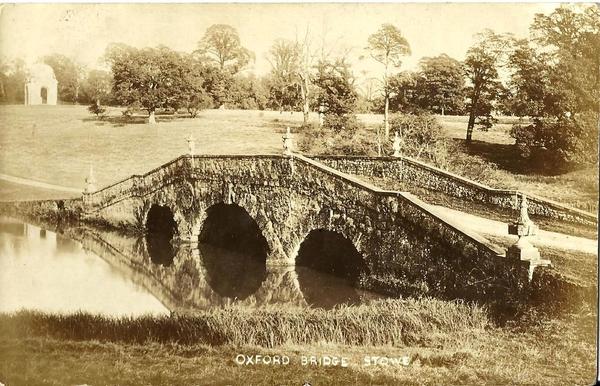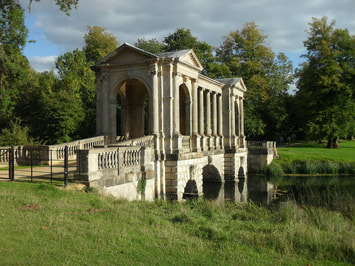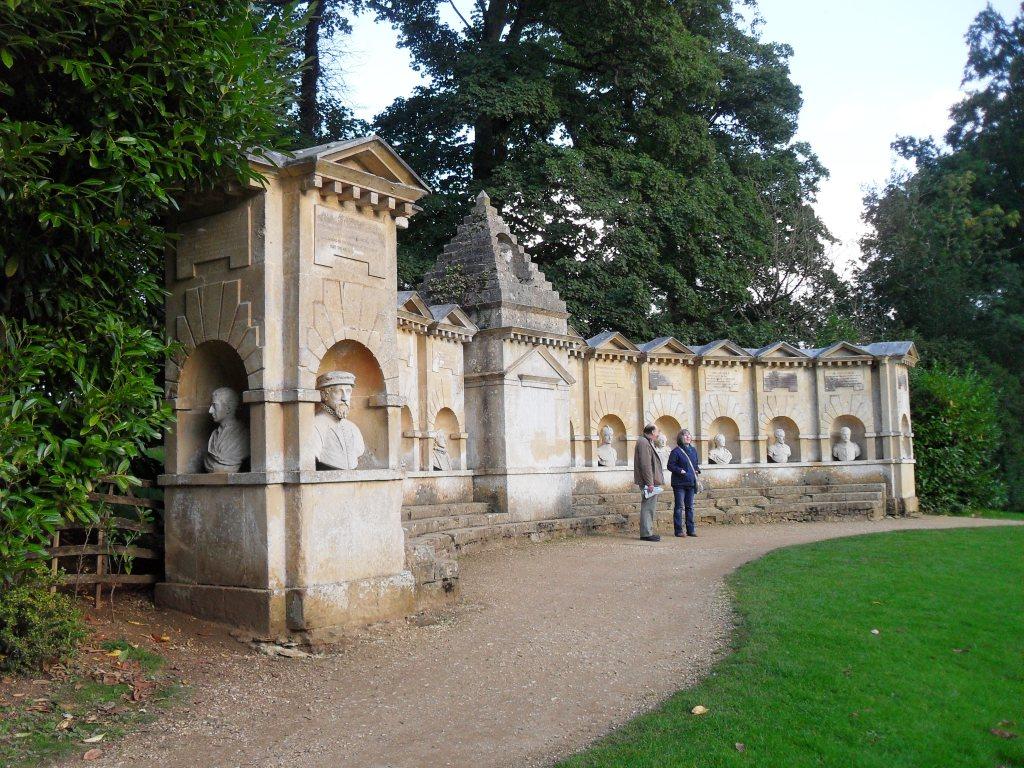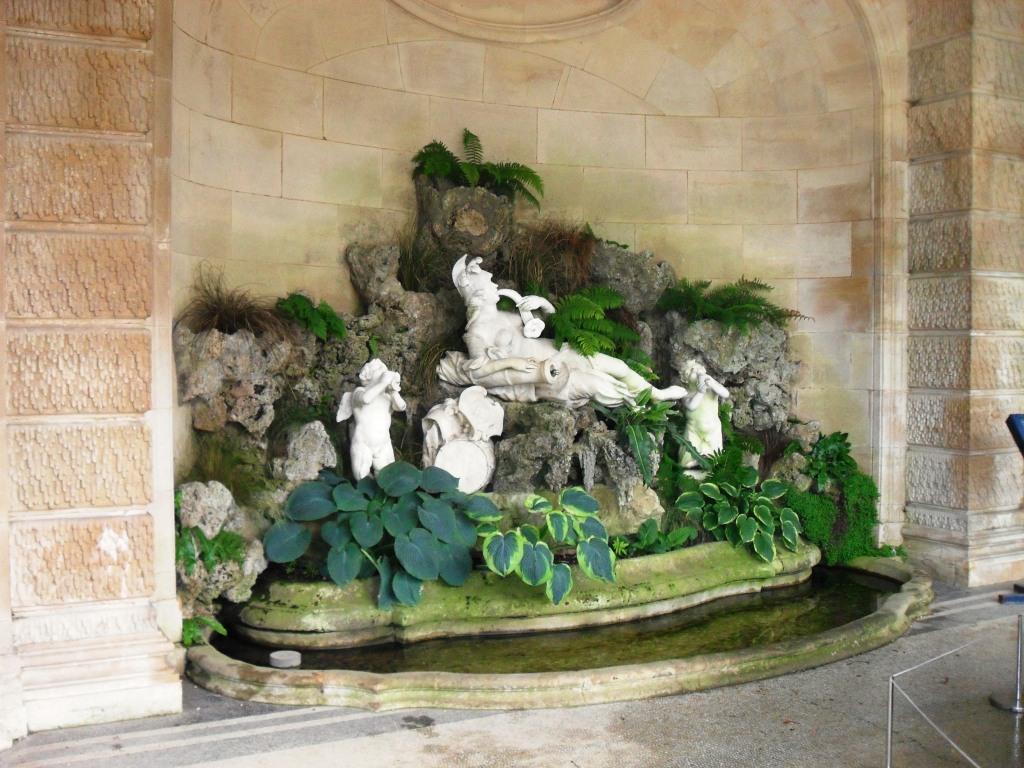Buckinghamshire
BEACONSFIELD SU 946 896
Hall Barn Oak Lodge
The lodge to Hall Barn was built in the 19th century and is covered with real and fake Early Renaissance and later panelling.
The lodge to Hall Barn was built in the 19th century and is covered with real and fake Early Renaissance and later panelling.
DINTON SP 765 115

Dinton Castle
John Vanhatten built the mock castle in 1769 as an eyecatcher from Dinton Hall. The walls are decorated with large ammonites that were from the local quarries. It is thought that non-conformists once used the folly as a meeting place.
Images below taken: 06/07/2012
John Vanhatten built the mock castle in 1769 as an eyecatcher from Dinton Hall. The walls are decorated with large ammonites that were from the local quarries. It is thought that non-conformists once used the folly as a meeting place.
Images below taken: 06/07/2012
ELLESBOROUGH SP 848 067

The Monument
The Monument at Coombe hill was erected in 1904 in memory of the 148 men from Buckinghamshire who died during the Second Boer War. The monument was almost totally destroyed by lightning in 1938 and was rebuilt the same year. The original bronze plaque was stolen in the 1980s and was replaced with a stone plaque. After it was struck by lightning again in the early 1980s, a conductor was fixed.
The Monument at Coombe hill was erected in 1904 in memory of the 148 men from Buckinghamshire who died during the Second Boer War. The monument was almost totally destroyed by lightning in 1938 and was rebuilt the same year. The original bronze plaque was stolen in the 1980s and was replaced with a stone plaque. After it was struck by lightning again in the early 1980s, a conductor was fixed.
STONE WITH BISHOSTONE AND HARTWELL SP 793 125

Egyptian Springs
Opposite a spring is a garden alcove seat designed in 1850 by Joseph Bonomi II; Dr John Lee's architect, Egyptologist and son of Joseph Bonomi.
There is a frieze with Egyptian hieroglyphics that record it being built in the 13th year of Victoria's reign.
Opposite a spring is a garden alcove seat designed in 1850 by Joseph Bonomi II; Dr John Lee's architect, Egyptologist and son of Joseph Bonomi.
There is a frieze with Egyptian hieroglyphics that record it being built in the 13th year of Victoria's reign.
STOWE SP 666 367
|
The Oxford Bridge
The Oxford Bridge was built in 1761 over a small lake called Oxford Water. Though the stonework is rusticated, it is of classical design and may have been based on an ancient Roman bridge that spanned the River Bacchiglione at Vicenza. The parapets have eight urns; the two pair at each end are probably from the Sleeping Parlour designed by John Vanbrugh but demolished in about 1760. |
STOWE SP 676 371

Amelian Arch
Thomas Pit designed the Doric Arch for Richard Temple that was erected in 1768 for the visit of Amelia, the aunt of George III, in 1770.
The arch also framed the view of the Palladian Bridge and was the entrance to the Elysian Fields.
Date taken: 29/07/2009
Thomas Pit designed the Doric Arch for Richard Temple that was erected in 1768 for the visit of Amelia, the aunt of George III, in 1770.
The arch also framed the view of the Palladian Bridge and was the entrance to the Elysian Fields.
Date taken: 29/07/2009
STOWE

The Chinese House
A description of Stowe in 1738 of a 'House built on piles, after the manor of the Chinese' could be the oldest reference in England of a Chinese-styled building.
Originally the Chinese House was 'in the middle of an old Pond' in the Elysian Fields, and was moved to Wooton in about 1750. It has now been restored and is back at Stowe.
A description of Stowe in 1738 of a 'House built on piles, after the manor of the Chinese' could be the oldest reference in England of a Chinese-styled building.
Originally the Chinese House was 'in the middle of an old Pond' in the Elysian Fields, and was moved to Wooton in about 1750. It has now been restored and is back at Stowe.
STOWE

The Cobham Monument
The 104 feet tall Cobham Monument was built in 1747-9, during the last two years of Richard Temple's life. James Gibbs made the initial design that was modified by Lancelot Brown.
The column is octagonal with a single flute on each side. It has an internal staircase leading to a small temple-like belvedere with eight arches and a dome that supports the statue of Cobham.
Date taken: 25/09/2015
The 104 feet tall Cobham Monument was built in 1747-9, during the last two years of Richard Temple's life. James Gibbs made the initial design that was modified by Lancelot Brown.
The column is octagonal with a single flute on each side. It has an internal staircase leading to a small temple-like belvedere with eight arches and a dome that supports the statue of Cobham.
Date taken: 25/09/2015
STOWE SP 678 370
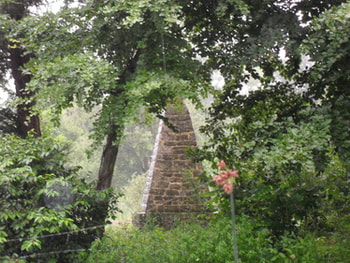
The Congreve Monument
The Congreve Monument was designed by William Kent in 1736 as a tribute to William Congreve from Richard Temple. A monkey is on the top of the pyramid looking at a mirror, just as Congreve held up a mirror to human nature in his plays. A Latin inscription reads:
'Comedy is the imitation of life and the mirror of society'.
Date taken: 29/07/2019
The Congreve Monument was designed by William Kent in 1736 as a tribute to William Congreve from Richard Temple. A monkey is on the top of the pyramid looking at a mirror, just as Congreve held up a mirror to human nature in his plays. A Latin inscription reads:
'Comedy is the imitation of life and the mirror of society'.
Date taken: 29/07/2019
STOWE SP 680 371
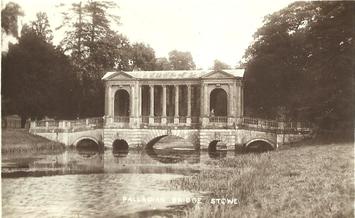
The Palladian Bridge
The Palladian Bridge at Stowe was built in 1738 and is similar to the one at Wilton that was erected in 1736-7
and inspired by Andrea Palladio's rejected design for the Rialto Bridge at Venice.
Other Palladian bridges are at:
WILTON Wiltshire
BATH Somerset
Also See SCAMPSTON East Riding
The Palladian Bridge at Stowe was built in 1738 and is similar to the one at Wilton that was erected in 1736-7
and inspired by Andrea Palladio's rejected design for the Rialto Bridge at Venice.
Other Palladian bridges are at:
WILTON Wiltshire
BATH Somerset
Also See SCAMPSTON East Riding
STOWE SP 679 374

Gothic Temple
The Gothic Temple was designed by James Gibbs in 1741 and was completed in 1744. It is dedicated 'To the Liberties of our Ancestors'.
The Gothic Temple was designed by James Gibbs in 1741 and was completed in 1744. It is dedicated 'To the Liberties of our Ancestors'.
STOWE SP 673 371
|
The Rotundo
John Vanbrugh designed The Rotundo in 1721 as a focal point from several of Bridgeman's radiating walks. The dome was replaced in 1752 with the present shallow one. The Ionic Rotunda at Duncombe Park, HELMSLEY, North Riding, is attributed to John Vanbrugh. Date taken: 29/07/2009 |
STOWE SP 676 372

The Temple of Ancient Virtue
The Temple of Ancient Virtue was designed by William Kent and built in 1737. It was based on the Temple of Vesta at Tivoli.
Date taken: 29/07/2009
The Temple of Ancient Virtue was designed by William Kent and built in 1737. It was based on the Temple of Vesta at Tivoli.
Date taken: 29/07/2009
STOWE SP 675 377

The Temple of Concord and Victory
Built in 1747, and known as the Grecian Temple, it was the first building in England in the Greek style.
Date taken: 29/07/2009
Built in 1747, and known as the Grecian Temple, it was the first building in England in the Greek style.
Date taken: 29/07/2009
STOWE SP 680 363

The Corinthian Arch
The Corinthian Arch was designed by Thomas Pitt and terminates the avenue to Buckingham.
The Corinthian Arch was designed by Thomas Pitt and terminates the avenue to Buckingham.

Date taken: 25/09/2015
STOWE SP 677 376

The Temple of Friendship
The Temple of Friendship was designed by James Gibbs and was completed in 1739.
Date taken: 29/07/2009
The Temple of Friendship was designed by James Gibbs and was completed in 1739.
Date taken: 29/07/2009
STOWE SP 676 373

The Grenville Column
Richard Temple had the column erected in memory of his nephew, Capt. Thomas Grenville, who died in a battle against the French off Cape Finisterre in 1747. It was originally placed in the Grecian Valley in 1749.
It is based on a Rostral column which was an Ancient Roman naval monument that had prows of galleys protruding from the shaft.
The Tuscan column's original statue of Neptune was replaced by a lead statue of Calliope by John van Nost.
Date taken: 29/07/2009
Richard Temple had the column erected in memory of his nephew, Capt. Thomas Grenville, who died in a battle against the French off Cape Finisterre in 1747. It was originally placed in the Grecian Valley in 1749.
It is based on a Rostral column which was an Ancient Roman naval monument that had prows of galleys protruding from the shaft.
The Tuscan column's original statue of Neptune was replaced by a lead statue of Calliope by John van Nost.
Date taken: 29/07/2009
STOWE SP 678 370

Pebble Alcove
The Pebble Alcove was probably designed by William Kent, and was built in 1739. Coloured pebbles form a mosaic of signs of the zodiac, stars, a whale, a robin and cherries. Richard Temple's coat of arms is in the centre with the Temple family motto 'TEMPLA QUAM DILECTA'; how beautiful are thy Temples.
Date taken: 29/07/2009
The Pebble Alcove was probably designed by William Kent, and was built in 1739. Coloured pebbles form a mosaic of signs of the zodiac, stars, a whale, a robin and cherries. Richard Temple's coat of arms is in the centre with the Temple family motto 'TEMPLA QUAM DILECTA'; how beautiful are thy Temples.
Date taken: 29/07/2009
STOWE SP 677 376

The Queen's Temple
Built in the 1740s and called the Lady's Building, the temple was remodelled in 1772 and the composite portico was based on the Temple of Dianna at Nimes.
The Temple of Diana at Blenheim, Oxfordshire, has a similar portico.
Date taken: 29/07/2009
Built in the 1740s and called the Lady's Building, the temple was remodelled in 1772 and the composite portico was based on the Temple of Dianna at Nimes.
The Temple of Diana at Blenheim, Oxfordshire, has a similar portico.
Date taken: 29/07/2009
STOWE SP 676 375
STOWE SP 676 375

Rock-work Arch
The Rock-work Arch at Stowe is above the Cascade at the Eleven Acre Lake.
Date taken: 29/07/2009
The Rock-work Arch at Stowe is above the Cascade at the Eleven Acre Lake.
Date taken: 29/07/2009
STOWE SP 677 372

The Temple of British Worthies
The exedra was designed by William Kent in about 1735. The niches contain busts by Rysbrack and Scheemakers.
The exedra was designed by William Kent in about 1735. The niches contain busts by Rysbrack and Scheemakers.
TAPLOW SU 912 855

Blenheim Pavilion, Cliveden
The Ionic style temple at Cliveden was designed by Giacomo Leoni in about 1727 to commemorate George Hamilton's victory at the Battle of Blenheim.
Date taken: 05/10/2011
The Ionic style temple at Cliveden was designed by Giacomo Leoni in about 1727 to commemorate George Hamilton's victory at the Battle of Blenheim.
Date taken: 05/10/2011
TAPLOW SU 909 850

Cliveden Chapel
Originally designed as a gazebo and grotto by Giacomo Leoni in 1735 for George Hamilton, in 1893 the building was converted for William Waldorf Astor into a chapel and Astor family mausoleum.
Date taken: 05/10/2011
Originally designed as a gazebo and grotto by Giacomo Leoni in 1735 for George Hamilton, in 1893 the building was converted for William Waldorf Astor into a chapel and Astor family mausoleum.
Date taken: 05/10/2011
TAPLOW SU 915 851

Cliveden Dovecote
The ornate Dovecote was built in 1869 for Hugh Lupus after he had bought Cliveden the previous year.
Date taken: 05/10/2011
The ornate Dovecote was built in 1869 for Hugh Lupus after he had bought Cliveden the previous year.
Date taken: 05/10/2011
TAPLOW SU 910 855
WADDESDON SP 731 165

The Aviary
The Rococo-style Aviary at Waddesdon Manor was built in 1889 for Ferdinand Rothschild.
Date taken: 06/07/2012
The Rococo-style Aviary at Waddesdon Manor was built in 1889 for Ferdinand Rothschild.
Date taken: 06/07/2012
WADDESDON

Cave
The outcrop is the work of James Pulham & Sons of Boxbourne.
The cave was intended to house Baron Ferdinand's Barbary sheep, but because of the smell it was used as a tool store. The water storage tank is above and forms the roof of the cave.
Date taken: 06/07/2012
The outcrop is the work of James Pulham & Sons of Boxbourne.
The cave was intended to house Baron Ferdinand's Barbary sheep, but because of the smell it was used as a tool store. The water storage tank is above and forms the roof of the cave.
Date taken: 06/07/2012
WEST WYCOMBE SU 827 949

The Mausoleum
The Mausoleum was designed by John Bastard the Younger, and built on the site of an Iron Age Hill Fort in 1765. The hexagonal building contains urns with the ashes of the Dashwood family. An inscription is to Sir Francis Dashwood, Lord le Despencer, and friends.
The Mausoleum was designed by John Bastard the Younger, and built on the site of an Iron Age Hill Fort in 1765. The hexagonal building contains urns with the ashes of the Dashwood family. An inscription is to Sir Francis Dashwood, Lord le Despencer, and friends.
WINGRAVE
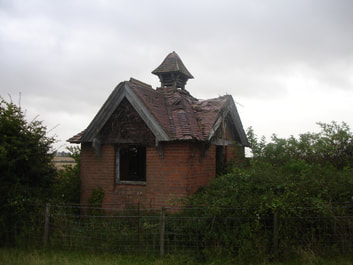
Pump house
The small decorative pump house in the corner of a field near Wingrave has now been demolished having suffered vandalism.
Date taken: 14/08/2007
The small decorative pump house in the corner of a field near Wingrave has now been demolished having suffered vandalism.
Date taken: 14/08/2007


